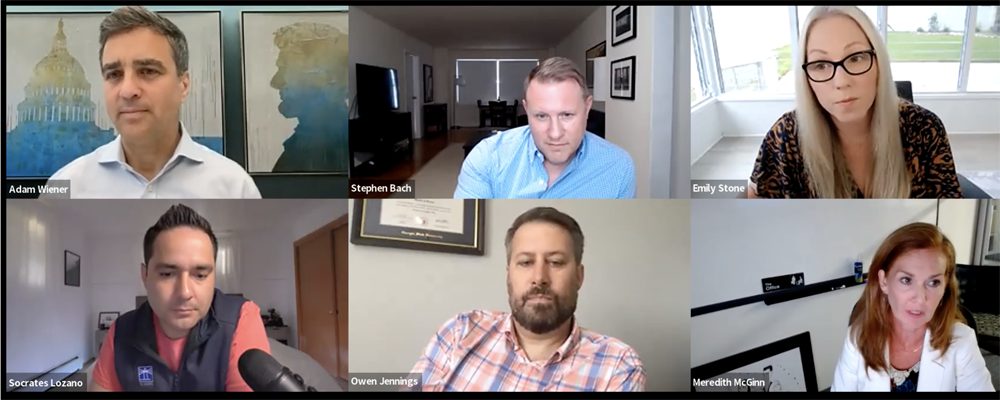
For News Streamers, Content And Workflow Challenges Are The Next Frontier

With robust growth in streaming, TV news organizations have been pivoting to embrace the platform, but planting the flag has been only the first step.
After launching FAST channels and apps to stake a presence on OTT, news organizations face a wave of more complicated choices. Chief among them are decisions around content and workflow integration. And many companies are treating streaming as if the very future of their news brands depends on it.
“The way that we’re building these channels [now] is the way that we’re going to build all channels going forward,” said Stephen Bach, sales manager for news verticals at Amagi, a cloud services company that works with broadcast and streaming TV partners, speaking at a TVNewsCheck webinar, Streaming News 2022: Optimizing News Content and Workflow Strategy, last Thursday (July 21).
Throughout the discussion, Bach and streaming executives from NBCUniversal Local, the E.W. Scripps Co., Cox Media Group and Fox Television Stations shared insights and strategies for content generation that has helped them try to gain an early competitive edge in the streaming landscape.
Exploring Automation Tools And The Hub And Spoke Model
To add streaming content production to a newsroom’s workload means the company must either hire new hands or place new responsibilities on staffers already in place — or both. Among the ways leaders can mitigate the impact an increase in work might have on personnel is to invest in automation, which is what the Cox Media Group has done in recent years.

Owen Jennings
“We want [staffers] to be focused on broadcast and creating great content digitally, and just not bogged down in the tools,” said Owen Jennings, the company’s executive director of product and innovation. He added that Cox expects to continue to invest in automation as it improves. “We just want the technology to kind of keep up with what we’re trying to do,” Jennings said.
When embarking on some of its first FAST-channel endeavors, NBCUniversal Local built what Meredith McGinn, EVP of diginets and original production, called “a small, consolidated hub team” to test streaming technology the company had invested in. That team put the tech “through its paces,” she said, created workflow norms, built schedules and then shared its successes with journalists and news managers across the local division.

Meredith McGinn
The hub members also engaged in ongoing conversation about opportunities making themselves apparent, in live events and other special events, to differentiate the channels, McGinn said. She was not alone in her advocacy for TV news hub teams.
“The hub and spoke model is really important and a key to success here,” said Socrates Lozano, senior director of ScrippsCast and newsroom innovation at Scripps. In achieving the goal of streaming differentiation, his team asks itself questions like: “What are those news stories that are uniform across a whole division, and does it make sense to reproduce that 40 times or once?” In choosing the latter approach, Lozano said the Scripps hub then feeds that content to local stations, freeing up time so they can focus more on local reporting “and creating differentiated content within the markets.”
Cross-Training Employees And Expanding Skill Sets
Hiring new staff to handle streaming production is an obvious solution to workflow issues at first blush. But even if companies choose to ignore the impact new hires may have on the bottom line and explore the job market, they’ll likely encounter additional challenges.

Emily Stone
“Every position is hard to hire,” said Emily Stone, VP of digital content operations at Fox Television Stations. Citing the heavily chronicled Great Resignation of the past year and a half, Stone said competition for talent is high. And with the emergence of the digital streaming technology, newsgroups want personnel with a range of abilities.
“We’re not only looking for someone who has news experience, understands journalism and has news judgment, we’re also looking for people who are tech savvy or at least can pick things up quickly, especially people with video experience,” Stone said. “It’s such a unique skill set.”
But workers like those are a rare commodity in a job market that’s already highly competitive. Stone said a solution is expanding the skill sets of team members already in-house.
“Here, our digital content creators are more focused on streaming and video and understanding that process and revamping their workflows to accommodate it than ever before,” Stone said. “Having them spending more time to focus on that means you’ve got that box checked.”
Even ensuring traditional broadcast staff holdovers know the new tech lingo is a hurdle. More than one panel participant said their organizations coordinate meetings to teach streaming-related acronyms tossed around newsrooms today with regularity.
“We’ve been holding streaming town halls over the last year to get folks comfortable speaking the language,” Cox’s Jennings said. “It is different, and you want to make sure no one feels left out. When people are saying ‘DAI’ and ‘slate,’ all of these are concepts that are just starting to roll off the whole team’s tongue.”
McGinn said her organization gathers small groups of workers together for similar meetings — modest in numbers because they might feel self-conscious asking questions about new verbiage in a large group setting.
Try And Fail … And Try Again
Panelists said one of the most exciting elements of the new streaming opportunities is the chance to explore the technology’s capabilities and experiment with content, free of scheduling limitations that are inherent to linear broadcasts.

Socrates Lozano
“Content prototyping is really important,” Lozano said. “We did prototype different ways of presenting the news … and ultimately some of that content failed. We went far in one way and ultimately what we discovered is there is some flexibility in there, in terms of what we can do, but ultimately what our viewer wants out of us is … to create [news] content that’s still relevant to their community.”
For the time being at least, consumers won’t mind TV news publishers taking their shots — even if they turn out to be air balls.
“You’re able to test and learn and that’s a beautiful thing about this audience,” said Adam Wiener, founder of Continuous Media, and the panel’s moderator. “They may come back and if you create a great product and you’re a known brand they’re going to trust you again, they’re going to try it again.”
Wiener, who for more than a decade led CBS Local Digital Media, suggested “testing segments and not shows.” The reason? Segments are shorter and, thus, the stakes are lower.
With streaming technology, too, organizations can test content, get instant feedback on its impact with viewers and adjust accordingly.
Stone noted that Fox LiveNOW started as a test, based out of the station group’s Phoenix market, and aired live on YouTube for a year before streaming it on its own website. What fueled its growth, in part, was that its producers were able to obtain viewership data immediately, providing insight into what resonated with viewers and what made them disconnect.
“You don’t get that with broadcast,” Stone said. “It’s just real-time feedback from your audience, which is just incredibly valuable in a testing process.”
She said the company looks closely at the time viewers spend watching LiveNOW as “an overall metric,” because having a lot of viewers watch for a second isn’t as valuable as having fewer viewers watch for an hour.
Experimentation is something networks should welcome not only on a macro level, but also more of a micro one, too. As Lozano noted, individual markets all have different needs and viewer expectations.
“It’s really important that we leave room for flexibility and innovation so that content producers can lean on what makes their specific local market special on streaming,” he said.


































Comments (1)
WIGUS55 says:
July 26, 2022 at 12:57 am
The streaming executives must take the same care as broadcasters with their playout. Most streaming platforms break for commercials in the middle of dialogue or in the middle of a scene change. It’s not acceptable for broadcast or cable and it shouldn’t be for streamers. Pluto, Tubi, You Tube, FreeVee and Crackle are among the worst protagonists.